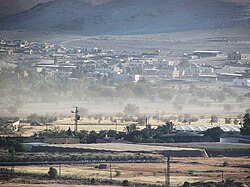Fasayil
| Fasayil | |
|---|---|
| Other transcription(s) | |
| • Arabic | فصايل |
| • Also spelled | al-Fasa'il (official) Khirbet al-Fasayil (unofficial) |

View of Fasayil al-Fauqa (north Fasayil), 2014
|
|
| Location of Fasayil within the Palestinian territories | |
| Coordinates: 32°01′30″N 35°26′36″E / 32.02500°N 35.44333°ECoordinates: 32°01′30″N 35°26′36″E / 32.02500°N 35.44333°E | |
| Palestine grid | 192/161 |
| Governorate | Jericho |
| Government | |
| • Type | Village council |
| Population (2007) | |
| • Jurisdiction | 1,078 |
Fasayil or Fasa'il (Arabic: فصايل) is a Palestinian village in the northeastern West Bank, a part of the Jericho Governorate, located 14 kilometres (8.7 mi) northwest of Jericho and about 40 kilometres (25 mi) southeast of Nablus. The closest Palestinian locality is Duma to the west. The village is located 2 km south of the Israeli settlement of Petza'el. According to the 2007 census by the Palestinian Central Bureau of Statistics (PCBS), the village had a population of 1,078.
Fasayil was known as Phasaelis. The village's ancient name derived from a tower that Herod the Great, the king of Judea (Roman province), built in the Jordan Valley north of Jericho in dedication to his elder brother Phasael. This has led to the belief that Herod founded Phasaelis. It was mentioned by Jewish historian and commander in the First Jewish-Roman War Josephus as being south of Archelais and was part of a toparchy ruled by Herod's sister Salome I. It is also found on the Map of Madaba surrounded by date palms. The tomb of an anchorite named Peter was found in the village in 1949.
The ruins of a monastery dedicated to Saint Cyriacus, a commemorated monk who died 556 CE, is also located in al-Fasayil. Among the ruins on the site is a large square building, of which now only the outline is visible, because it is almost completely buried. At the mouth of the nearby Wadi al-Fasayil, in a little mound, there is a birkeh ("pool") and many unexcavated remains of walls. The site is called Tell Sheikh ad-Diab because of a tomb of this personage, still in good condition.
...
Wikipedia

